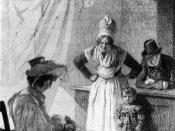The 19th century woman lived a life shadowed by men. Their lives were dictated by their husband and his choices. Consequently, their lives were suppressed by the limitations of their gender in addition to the boundaries of class. This led to the need for women, in order to obtain some sense of freedom, to pursue a man of higher class and overcome the boundaries between classes. In the novel Madame Bovary by Gustave Flaubert, these characteristics of the 19th century society are all prevalent. Flaubert portrays this suppression of women by men and their societal hierarchy through the illustrious use of symbolism. Madame Bovary is a typical 19th century middle class woman who is bounded by her gender and aspires to transcend the limitations of her class. While still being married, Madame Bovary pursues numerous romantic engagements in order to fulfill her sensual desires and her need to become of the higher class.
However, her desires eventually consume her and lead to her ultimate demise. In Madame Bovary, Gustave Flaubert repeatedly uses windows, the child, and horses to reveal the powerlessness and suppression of women in the 19th century.
Through the use of windows, Flaubert characterizes Madame Bovary as a suppressed woman constantly bound by her marriage and status. The windows in Madame Bovary facilitate the dreams and aspirations of the Emma Bovary. Upon meeting Charles for the first time, Emma is shown staring through a window into her garden dreaming of the possibility of marriage and romance. However, after their union, when Emma is disillusioned from the false romance of romance novels, she passes "three windows whose perpetually closed shutters were rattling away on their rusty iron bars" (43). Flaubert's reference to these closed windows during Emma's disillusionment shows her feelings of entrapment with a man who...


